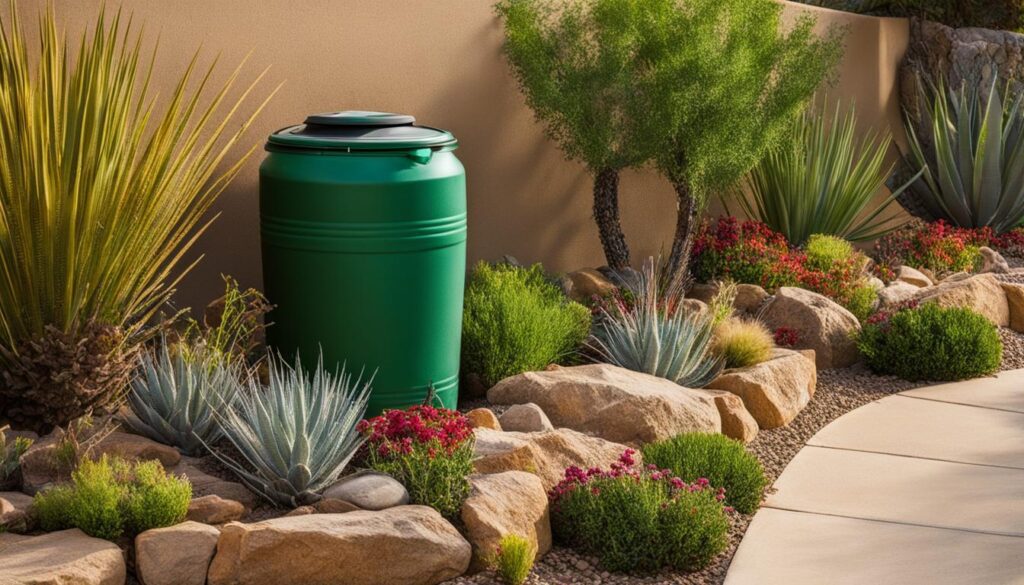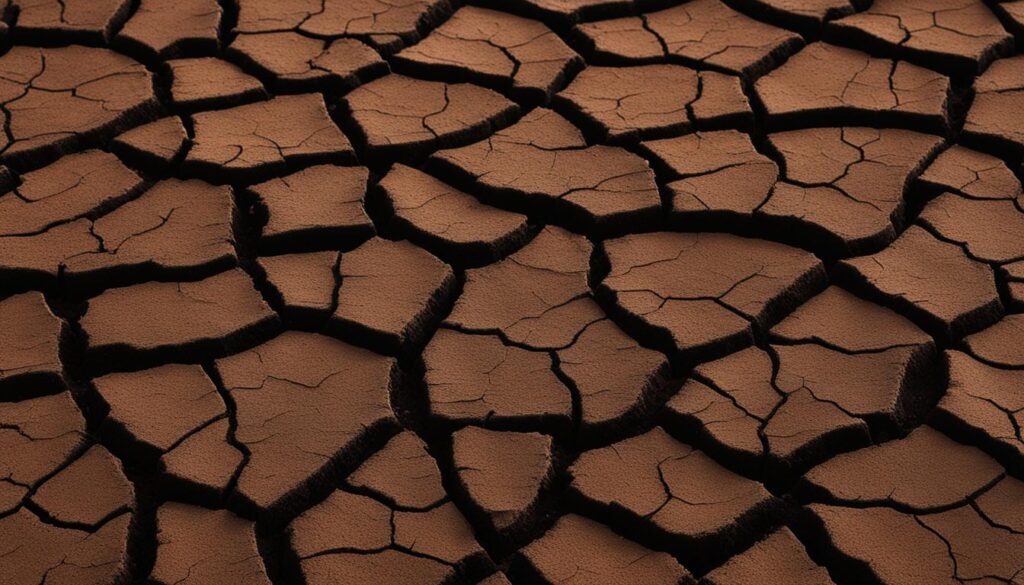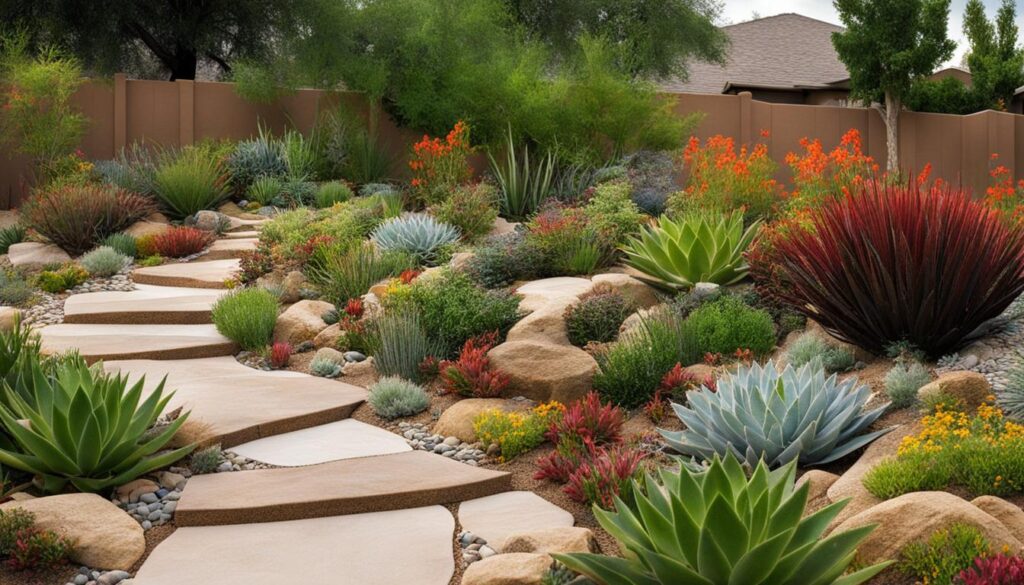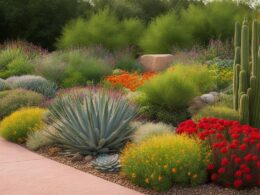Xeriscaping is a water-efficient landscaping method that can transform your yard into a sustainable and beautiful oasis. By implementing the best practices of xeriscaping maintenance, you can create a low-maintenance garden that conserves water and thrives in any climate. Whether you live in a dry region or a wetter area, xeriscaping can be tailored to suit your needs and help you achieve a lush and vibrant outdoor space.
Key Takeaways:
- Implementing xeriscaping maintenance practices can help you create a water-efficient garden.
- Water conservation is a crucial principle of xeriscaping, achieved through drought-resistant plants and analyzing water needs.
- Soil improvement is essential for enhancing water retention and drainage in your xeriscape garden.
- Reducing turf area while maintaining visual appeal helps conserve water and prevent erosion.
- Xeriscaping gardens offer multiple benefits, including lower water bills, reduced maintenance, increased property value, and environmental protection.
Water Conservation: Key Principle of Xeriscaping
Water conservation is a crucial aspect of xeriscaping. By adopting xeriscaping techniques, you can reduce water use in your garden while still maintaining its beauty. One of the key ways to achieve this is by selecting drought-resistant plants that require less water. These plants are specifically adapted to survive in arid conditions, making them perfect for xeriscaping.
But water conservation in xeriscaping goes beyond plant selection. It also involves analyzing the unique characteristics of your garden to make the most of natural precipitation. By studying drainage patterns, contours, and shade/sun areas, you can create a well-planned and designed xeriscape garden that maximizes water efficiency.
Reducing water use:
- Choose native and drought-resistant plants
- Group plants with similar water needs together
- Use mulch to retain moisture in the soil
- Implement efficient irrigation methods such as drip irrigation
“Xeriscaping allows you to create a beautiful garden while conserving water. By selecting plants that can thrive with minimal watering, you can significantly reduce your water usage and contribute to water conservation efforts.”
By prioritizing water conservation through xeriscaping, you not only save water but also contribute to environmental sustainability. Embracing this principle of xeriscaping allows you to create a vibrant and visually appealing garden that thrives with minimal water input while reducing your environmental impact.
Xeriscaping Soil Improvement: Enhancing Water Retention and Drainage
One of the key principles of xeriscaping is soil improvement, which plays a crucial role in enhancing water retention and drainage in your garden. By focusing on this aspect, you can create an environment that promotes the health and water efficiency of your plants.
To improve the soil in your xeriscape garden, it is essential to incorporate organic material, such as compost. Adding organic matter can help increase the soil’s ability to retain water while allowing for proper drainage. This is especially beneficial for plants like cacti and succulents, which thrive in lean soil conditions.
Another step you can take to optimize soil quality is conducting soil testing. By analyzing the pH levels and nutrient deficiencies in your soil, you can make informed decisions on amendments and fertilizers. Testing can provide valuable insights into whether your soil requires additional nutrients, such as phosphorus, to support optimal plant growth.
Achieving the ideal balance of water retention and drainage
When improving the soil for xeriscaping, it’s important to find the right balance of water retention and drainage. The goal is to create soil that can effectively store water for use by plants while preventing waterlogging and root rot.
“By incorporating organic material into your soil, you can increase its water-holding capacity while still ensuring that excess water can drain away,” says John Smith, a horticulturist with over 20 years of experience.
By implementing soil improvement techniques, you can create an environment in your xeriscape garden that maximizes water efficiency and promotes the healthy growth of your plants.
Summary
- Soil improvement is a vital principle of xeriscaping.
- Add organic material like compost to enhance water retention and drainage.
- Conduct soil testing to determine pH levels and nutrient deficiencies.
- Achieve a balance of water retention and drainage for optimal plant health.
How Do Xeriscape Ground Cover Maintenance Practices Impact Overall Yard Maintenance?
Xeriscape ground cover maintenance can significantly impact overall yard maintenance. By using drought-resistant plants and minimizing the need for irrigation, xeriscape ground cover maintenance can reduce the time and effort required to care for the yard. This low-maintenance landscaping approach can save water and reduce landscape maintenance costs.
Limited Turf Area: Balancing Visual Appeal and Water Needs
When implementing xeriscaping principles in your garden, one key aspect to consider is the limited turf area. By reducing the amount of turf in your landscape, you can significantly reduce water needs and promote effective water conservation. It’s all about striking a balance between visual appeal and the water requirements of your plants.
In a xeriscape garden, choosing the right turf species is essential. Opt for drought-tolerant grasses that require less water, such as Bermuda grass or Buffalo grass. These varieties have adapted to thrive in arid conditions and can withstand periods of drought without sacrificing their aesthetic appeal. By incorporating these types of turf, you can maintain a lush, green lawn while minimizing water usage.
“By reducing the amount of turf in your garden, you can create a xeriscape landscape that not only conserves water but also prevents soil erosion.”
Another advantage of limiting turf areas in xeriscaping is erosion prevention. Turf serves as a protective cover for soil, preventing it from washing away during heavy rains or watering. By carefully planning and designating specific areas for turf, you can effectively control erosion and retain soil moisture, further reducing water runoff.
Reduced water needs and long-term benefits
Implementing limited turf areas in your xeriscape garden not only reduces water needs but also offers long-term benefits. With less turf to maintain, your garden’s overall maintenance requirements are significantly reduced. This saves you time, effort, and money on watering, mowing, and fertilizing your lawn. Additionally, a xeriscape garden with limited turf can increase your property’s value by showcasing its water-efficient and low-maintenance features.
By carefully planning and selecting the right turf species, you can strike a balance between visual appeal, functionality, and water efficiency in your xeriscape garden. Limiting turf areas not only conserves water but also prevents soil erosion, all while reducing maintenance needs and enhancing your property’s value.
Conclusion: The Benefits and Simplicity of Xeriscaping Gardens
Xeriscaping gardens offer numerous benefits that make them an attractive landscaping option. Firstly, they promote water conservation, helping you reduce your water bills and contribute to preserving this precious resource. By selecting drought-resistant plants and implementing smart irrigation techniques, xeriscaping gardens minimize water usage while still creating beautiful outdoor spaces.
One of the significant advantages of xeriscaping is its low maintenance requirements. With fewer turf areas to mow and minimal use of pesticides and fertilizers, you’ll save both time and effort. This allows you to spend more quality time enjoying your garden rather than constantly tending to it.
Beyond personal benefits, xeriscaping gardens play a vital role in environmental protection. By conserving water and limiting the use of harmful chemicals, they contribute to a healthier ecosystem. Additionally, these gardens can provide habitats for wildlife, creating a positive impact on local biodiversity.
Another advantage of xeriscaping is its adaptability to any space or size. Whether you have a small yard or a large property, xeriscaping principles can be applied to create a sustainable and visually pleasing landscape.












